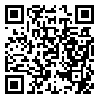Volume 6, Issue 6 (2015)
LRR 2015, 6(6): 201-227 |
Back to browse issues page
Download citation:
BibTeX | RIS | EndNote | Medlars | ProCite | Reference Manager | RefWorks
Send citation to:



BibTeX | RIS | EndNote | Medlars | ProCite | Reference Manager | RefWorks
Send citation to:
abdolkarimi S. Study of Different Kinds of Synonymy between Persian Non-compound Verbs and their Formal-Semantic Equivalent Compound Verbs. LRR 2015; 6 (6) :201-227
URL: http://lrr.modares.ac.ir/article-14-8783-en.html
URL: http://lrr.modares.ac.ir/article-14-8783-en.html
Assistant professor of linguistics at shahid beheshti university, Tehran, Iran
Abstract: (5867 Views)
The Present research is a semantic attempt to the semantic exploration of Persian non- compound verbs and their formal-sematic equivalent compound verbs with the aim of showing which kind(s) of synonymy there are between these equivalents. In this study, first, the author’s point of view about Persian compound and non-compound verbs are explained and then, after mentioning different methods of making compound verbs out of non-compound verbs in Persian, different kinds of synonymy from semanticists’ point of view have been introduced and explained. After a short discussion about different kinds of synonymy, through using examples, we try to argue which kinds of synonymy there are between discussed equivalents. To reach this goal, 363 non-compound verbs which have formal-semantic equivalent compound verbs have been collected from Sokhan 8-vol. Persian dictionary. The corpus has been attached to the article as an appendix. The results of the investigations have shown that absolute synonymy and implied synonymy do not exist between these equivalents, but other kinds of synonymy; namely near synonymy, analytical synonymy, descriptive synonymy, partial synonymy, propositional synonymy do exist between the studied equivalents.
Keywords: semantic analysis, synonymy, noncompound verb. compound verb and formal-semantic equivalent
| Rights and permissions | |
 |
This work is licensed under a Creative Commons Attribution-NonCommercial 4.0 International License. |






